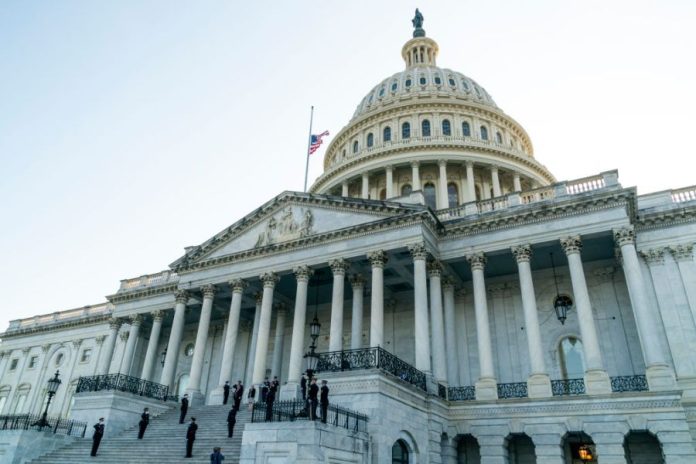
The recently passed One Big Beautiful Bill Act increased the debt limit to $41.2 trillion, or 136 percent of GDP.
Some believe that Congress will have to raise the debt limit again before the 2026 election. But here is a bold idea for Republicans to show that they remain the party of limited government: Vote to decrease the debt limit, and do it soon.
If President Trump has taught us anything, it’s that we should get out of our status quo ruts and explore the broader horizon of policy possibilities. It is time to reevaluate how we officially measure the debt. The U.S. dollar, important as it is, is simply not a great measure for evaluating fiscal policy. This is why the Congressional Budget Office and the White House Office of Management and Budget already present data in both current dollars and as a percentage of GDP.
We have had a top-line debt ceiling in U.S. dollars since 1939, but we would be much better served setting the debt limit as a percentage of GDP.
First some background, the Constitution gives Congress the “power of the purse,” meaning Congress is ultimately tasked with both tax collection and spending policy. Congress determines how much we can spend and borrow, and Congress periodically adjusts how it handles the debt limit.
Prior to World War I, the debt limit was effectively set by Congress authorizing bonds to borrow and pay for specific projects — for example, 1840’s Mexican-American War bonds and early 1900’s Panama Canal construction bonds. After the Great War, with debt at unprecedented levels and the increasing complexity of financial markets, the secretary of the Treasury was given more latitude for managing federal debt, and in 1939 the modern top-line debt ceiling approach was established.
However, a lot has changed since then. Today’s fiat currency is no longer connected to a stable asset like gold. Increases in money supply — and resulting inflation — have compromised the dollar as a stable measure of value. Congress should therefore use our national GDP as a smarter measure for the federal debt limit.
Consider that Federal Debt in 1946, after World War II, was about $242 billion; that number tells us little. On the other hand, knowing that the debt level was 106 percent of GDP. That tells us both the real size of that burden then and its relation to today. It helps us understand our nation’s ability to repay its debt.
For perspective, our recently increased $41.2 trillion debt limit is about 136 percent of GDP. After GDP growth, CBO projects that GDP will be $31.3 trillion in 2026, dropping the unchanged $41.2 trillion debt limit to about 131.6 percent of GDP.
To give a little wiggle room, Congress should set the debt limit at 132 percent of GDP, but it should not stop there. In the same bill that drops the debt limit from 136 percent of GDP to 132 percent of GDP, Congress should provide for the debt limit to decrease by an additional percentage point every year through the end of the 21st century. This would result in a debt limit that is 58 percent of GDP by 2100 — on par with federal debt in 1954. Alternatively, Congress could take a more aggressive approach with annual decreases of 1.25 points, which would put the debt on par with its 1988 levels in the same time frame.
Among the benefits, this approach would put us on a credible and sustainable path to radically reduce our national debt as the economy grows. Also, it would reduce economic volatility and anxiety over debt limit politics risking default on Treasury debt. This could help to lower interest rates both for federal debt — reducing our interest payments — and ultimately reduce costs on consumer loans.
The debt limit would stay firm at a set percentage of GDP, even when inflation and interest payments force the current dollar level marginally higher. And if some emergency transpires or a deep recession hits us, nothing prevents a future Congress from increasing the limit percentage or issuing special bonds to handle the situation.
Even so, given that we are already at historically high rates of debt as a percent of GDP, there will never be a better time than now to start reducing the debt.
The U.S. is on the brink of numerous fiscal crises. Some we know about, and others we don’t. Social Security and Medicare insolvency are two obvious ones. The broader economic and federal budget revenue flows emerging from demographic changes are another. The unknowns are recessions, wars, pandemics, and other tumultuous events. Presently, we are headed in a bad fiscal direction, which will limit our ability to address coming crises. This is why it is so important that we take a step to reduce our debt burden. Linking the debt limit to a declining percentage of GDP could be just the step we need.
Even if Congress puts the debt-to-GDP ratio on a downward slope, the job does not finish there. At the high rate of spending to which Congress has become accustomed, pressure will remain to increase the debt limit both from within the halls of Congress and from the growing interest payments associated with past spending decisions. However, the gradual reductions related to the annual one-percent debt limit decreases will hopefully be enough to help keep the country on track.
This is a real opportunity for both Republican and Democratic leaders to step forward and find agreement on a credible path to fiscal discipline. This could be a moment for real statesmen to emerge in both parties.
Doug Branch, a former House and Senate staffer for more than two decades, is a senior fellow and director of strategic outreach for the Fiscal Lab on Capitol Hill.

